Questions to ask when considering outsourcing
1. What are the benefits of outsourcing?
One of the biggest advantages of outsourcing is that it can help businesses save money. By outsourcing tasks that are typically done in-house, such as payroll processing or customer service, companies can reduce their overhead costs and free up resources for other areas of the business. Outsourcing can also improve efficiency, as specialized providers are often able to perform tasks faster and more accurately than in-house teams.
2. What are the risks of outsourcing?
While outsourcing can be a great way to save money and improve efficiency, it’s not without its risks. One of the biggest risks is that you may not be able to find a partner that is a good fit for your business. It’s important to carefully research potential providers and look for those that have experience in the tasks you need help with. You should also be prepared for communication issues, as working with a provider located in another country can be challenging. Additionally, there are concerns about data security and compliance when outsourcing, so it’s important to make sure that your partner has robust security measures in place.
3. What tasks should I outsource?
When considering outsourcing, it’s important to identify the tasks that would benefit most from being done by a specialized provider. Some common tasks that are often outsourced include payroll processing, customer service, IT support, and marketing. However, before you start outsourcing, you should consider the tasks that are critical to your business and determine which ones can be effectively handled by an outside partner.
4. What is the cost of outsourcing?
The cost of outsourcing will depend on a variety of factors, including the complexity of the task, the location of the provider, and the level of expertise required. Some providers charge by the hour or by project, while others may have retainer agreements that allow you to pay a fixed price for ongoing services. It’s important to get clear pricing from potential partners and consider all the costs associated with outsourcing, including any additional expenses related to communication or data security.
5. How do I find the right provider?
When searching for an outsourcing partner, it’s important to look for providers that have experience in the tasks you need help with. You should also consider factors such as location, language capabilities, and cultural compatibility when choosing a provider. Researching potential partners and reading reviews from other businesses can be helpful, but it’s also a good idea to reach out directly to providers and ask for references or case studies.
6. What are the legal considerations of outsourcing?
When outsourcing, there are important legal considerations that you should be aware of. These include issues related to data privacy and security, as well as compliance with local labor laws. It’s important to work with a provider that has experience in navigating these issues and can help you ensure that you are compliant with all relevant regulations.
7. How do I manage communication when outsourcing?

Communication is key when working with an outsourcing partner, and it’s important to establish clear communication channels from the beginning. This may include regular video or phone calls, email updates, or project management software. It’s also important to establish clear expectations for response times and to be prepared for any potential language barriers or cultural differences.
8. What is the impact of outsourcing on my business?
Outsourcing can have a significant impact on your business, both positive and negative. On one hand, it can help you save money and improve efficiency, which can lead to increased revenue and profitability. However, it’s important to carefully consider the impact of outsourcing on your business and to ensure that it aligns with your overall goals and objectives.
Case Studies
One example of a company that has successfully outsourced is HubSpot, a marketing software provider based in Boston. According to HubSpot’s CEO, Brian Halligan, the company decided to outsource some of its customer service functions to a provider in India. This allowed the company to scale its customer service operations quickly and cost-effectively, without sacrificing quality.
Another example is Zappos, an online shoe retailer based in Las Vegas. Zappos outsources many of its IT support functions to a provider in Manila, Philippines. According to Zappos’ CTO, Jenny Flint, this allowed the company to focus on building its core business and providing excellent customer service, without being constrained by resource limitations.
Expert Opinions
According to a survey conducted by the Global Sourcing Council, 75% of companies that outsource report cost savings as one of the main benefits of outsourcing. However, the survey also found that communication is the most significant challenge for companies when outsourcing, with 43% of respondents citing this as a major issue.
When asked about the impact of outsourcing on their business, 56% of respondents in the survey said that it had led to increased efficiency and productivity, while 28% said that it had improved the quality of their products or services.


















